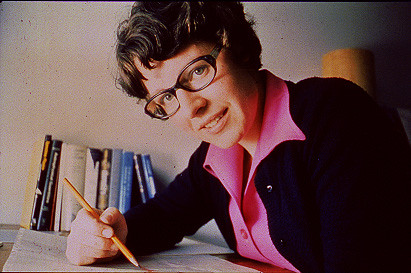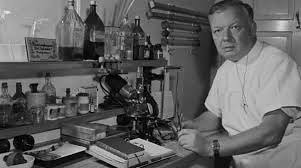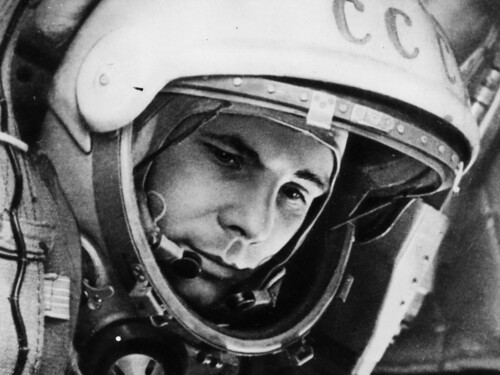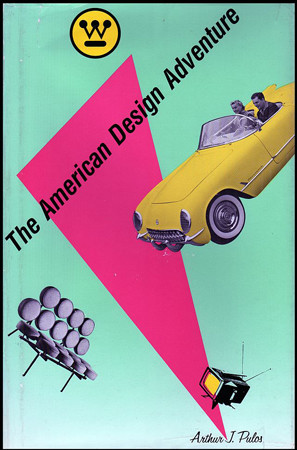The American Design Adventure
Mark Twain once said that the only thing Americans really had in common with one another was a fondness for iced water.
This book offers a much-needed sense of the method behind the multiplicity of American design. It’s a pioneering work, even though it has important flaws.
Pulos’s scholarship is good. However, there is too much about competitions, exhibitions, professional societies, design education and the Museum of Modern Art, even though Pulos is candid about their generally limited impact. Also, the author’s political economy is weak. There is uncritical endorsement for Adam Smith, and for design as an instrument of what, in a bizarre Introduction to Adventure, Pulos terms ‘barter’. There is a tone of injured, protectionist sensitivity whenever imports from Europe rear their head.
‘Building the World of Tomorrow’, the New York World’s Fair of 1939-40, starts us on a brilliant survey of dreams and realities in the early 1940s. Of dreams there were plenty: Henry Dreyfuss, Raymond Loewy, Donald Deskey, Russel Wright and the entirely dotty Norman Bel Geddes, designers to the Fair and to much of mid- century America, were obsessed with science fiction futures. Dreyfuss, who earlier did the Bell telephone, now tried space-age evening dresses for Vogue. As for Bel Geddes, his highly popular Futurama exhibit, a 1960 USA spanned by 14-lane motorways, caused a massive furore.
Soon realities crowded in. Pulos covers the Jeep swiftly and then turns in a remarkable passage on US designers and the war effort. Dreyfuss, Loewy and Walter Dorwin Teague, he mentions, designed strategy rooms for the Joint Chiefs of Staff, and Dreyfuss did 13-foot globes for FDR, Churchill and Stalin to plan battles on. Loewy was consultant to the Office of Strategic Services, predecessor of the CIA, in a mysterious-sounding Department of Visual Presentation. Teague won a citation from the Navy for his work in ordnance. Bucky Fuller did Dymaxion Deployment Units for use by the armed forces in the Pacific and the Persian Gulf. Charles Eames, as is well known, did wooden splints for the Navy, while Eliot Noyes met Tom Watson Jr, later his client at IBM, in the Pentagon’s planes department. And Bel Geddes? His chess-like wargame panoramas for the military included, Pulos notes, ‘a number of pre-invasion models for events that never occurred, such as a battle of Gibraltar, landings on the north coast of Germany, and a tank battle in the USSR’.
Pulos coasts through all this with finesse. His sketches of less prominent designers are exemplary. He shows how Durez plastics and Libbey-Owens-Ford glass, taking advantage of their products’ popularity during the shortages of war, organised utopian ‘kitchens of the future’ for an admiring public whose hopes were later dashed. He deals well with wartime trailer homes, late-1940s prefabricated and Levitt houses, and with what he terms the ‘exotic’ early-1950s influence of Scandinavian furniture.
Pulos’s pictures, despite b&w, are fine. He accurately attacks US post-war lighting and is justifiably cool on how, in the Third World, Teague, Wright and others, aided by the White House’s International Cooperation Administration, tried and failed ‘to help unstable countries maintain their political independence by developing a secure and promising economy’. But Pulos will not ground his insights with any sense of America’s mid-century might, or of its de-industrialisation since. Instead of being reminded that US output, capacity and exports were massively strengthened by its Allies’ wartime travail, or that Keynesian full employment policies were what allowed Bel Geddes’ motorways to be built, we hear complaints of the ‘formidable competition’ facing the USA from overseas. We touch on 1960s revolt and 1970s ‘smokestack industries’, but the atmospheres or products of the atomic era, the Cold War, the Korean boom or the Vietnam war barely figure. We learn nothing of Madison Avenue, ‘motivational research’ and the Harvard Business Review line on design in the 1950s. Rather, we face but alternating buyers’ and sellers’ markets, and an Epilogue where the USA leads other countries in using design to reach ethnic, social and economic ‘equilibrium’.
Fmr President of Kenya on Trump cutting off foreign aid:
“Why are you crying? It’s not your government, he has no reason to give you anything. This is a wakeup call to say what are we going to do to help ourselves?”
America first is good for the world.
Our entire Green Socialist establishment should be banged up under the ‘Online Safety’ laws, for spreading demonstrable lies (the ‘climate crisis’), causing non-trivial harm to the industrial working class, ordinary drivers, farmers, taxpayers etc, etc.
#Chagos? #Mauritius PM Navin Ramgoolam "is reported to want Starmer to pay £800m a year, plus ‘billions of pounds in #reparations’." (14 January) https://www.spiked-online.com/2025/01/14/the-chagos-islands-deal-is-an-embarrassment/
Now the Torygraph wakes up https://telegraph.co.uk/gift/1ff8abbb462cd609
Read @spikedonline - first with the news!
Articles grouped by Tag
Bookmarks
Innovators I like

Robert Furchgott – discovered that nitric oxide transmits signals within the human body

Barry Marshall – showed that the bacterium Helicobacter pylori is the cause of most peptic ulcers, reversing decades of medical doctrine holding that ulcers were caused by stress, spicy foods, and too much acid

N Joseph Woodland – co-inventor of the barcode

Jocelyn Bell Burnell – she discovered the first radio pulsars

John Tyndall – the man who worked out why the sky was blue

Rosalind Franklin co-discovered the structure of DNA, with Crick and Watson

Rosalyn Sussman Yallow – development of radioimmunoassay (RIA), a method of quantifying minute amounts of biological substances in the body

Jonas Salk – discovery and development of the first successful polio vaccine

John Waterlow – discovered that lack of body potassium causes altitude sickness. First experiment: on himself

Werner Forssmann – the first man to insert a catheter into a human heart: his own

Bruce Bayer – scientist with Kodak whose invention of a colour filter array enabled digital imaging sensors to capture colour

Yuri Gagarin – first man in space. My piece of fandom: http://www.spiked-online.com/newsite/article/10421

Sir Godfrey Hounsfield – inventor, with Robert Ledley, of the CAT scanner

Martin Cooper – inventor of the mobile phone

George Devol – 'father of robotics’ who helped to revolutionise carmaking

Thomas Tuohy – Windscale manager who doused the flames of the 1957 fire

Eugene Polley – TV remote controls



0 comments